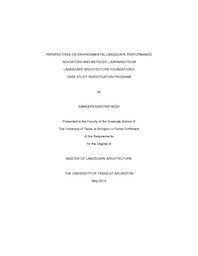
ATTENTION: The works hosted here are being migrated to a new repository that will consolidate resources, improve discoverability, and better show UTA's research impact on the global community. We will update authors as the migration progresses. Please see MavMatrix for more information.
Show simple item record
| dc.contributor.author | Modi, Sameepa Kashyap | en_US |
| dc.date.accessioned | 2014-07-14T20:26:29Z | |
| dc.date.available | 2014-07-14T20:26:29Z | |
| dc.date.issued | 2014-07-14 | |
| dc.date.submitted | January 2014 | en_US |
| dc.identifier.other | DISS-12677 | en_US |
| dc.identifier.uri | http://hdl.handle.net/10106/24431 | |
| dc.description.abstract | Case studies are frequently utilized in landscape architecture to evaluate finished projects and to inform future education and practice (Francis, 1999 and 2003; Ahern et.al., 2007). The effective dissemination of developing theories and knowledge base in the landscape architecture profession seems promising with the adaptation of case study methods (Francis, 2001). The case studies are specifically found to be suitable in landscape performance studies as it can be easily adapted to various project types. Numerous case studies are found in landscape architecture literature, especially after Francis' seminal work in 1999 on the case study method, and more structured study attempts such as the Case Study Investigation (CSI) Program initiated by Landscape Architecture Foundation (LAF) in 2011, giving more prominence to such methods (LAF, 2013). 62 case study briefs are published up to date but they have not been reviewed and scrutinized collectively, specifically for the rigor of environmental indicators and methods, to better understand their contribution to landscape architecture scholarship. The purpose of this research is to review the environmental landscape performance indicators and methods adopted in LAF's CSI Program and assess their significance in landscape architecture based on the perception of CSI participants. The research also discusses the views of CSI participants about the environmental performance indicators and methods as well as the influence of LAF's CSI Program on the understanding of environmental performance in landscape architecture research and practice.Qualitative research methods are adopted in this research to review the perceptions of researchers and professionals, regarding environmental landscape performance indicators and methods. The case studies are systematically reviewed and documented from the CSI program between 2011- 2013 (LAF, 2013). An in-depth interview method was used to have a clear understanding of perception of informants on environmental landscape performance indicators and methods (Taylor and Bogdan, 1998). Interviews are later transcribed, analyzed, and common themes are identified to extract findings which are compared with the content analysis of the literature (Krippendorff, 2004). Since the inception of CSI Program in 2011, 121 environmental landscape performance indicators and 201 methods are utilized in 62 case study briefs. Also 15 major themes emerge for environmental performance indicators and methods from combined analysis of literature review and interview transcripts. More views about the rigor of environmental performance indicators were obtained from researchers as compared to practitioners' concern about outcome. The rigor of the method and case study is highly driven by availability of time, funding and resources. In conclusion, the research suggests the importance of greater understanding of environmental landscape performance indicators and methods to build a reliable knowledge base towards knowledge creation and performance oriented landscape architecture profession and scholarship. | en_US |
| dc.description.sponsorship | Özdil, Taner | en_US |
| dc.language.iso | en | en_US |
| dc.publisher | Landscape Architecture | en_US |
| dc.title | Perspectives On Environmental Landscape Performance Indicators And Methods: Learning From Landscape Architecture Foundation's Case Study Investigation Program | en_US |
| dc.type | M.L.A. | en_US |
| dc.contributor.committeeChair | Özdil, Taner | en_US |
| dc.degree.department | Landscape Architecture | en_US |
| dc.degree.discipline | Landscape Architecture | en_US |
| dc.degree.grantor | University of Texas at Arlington | en_US |
| dc.degree.level | masters | en_US |
| dc.degree.name | M.L.A. | en_US |
Files in this item
- Name:
- Modi_uta_2502M_12677.pdf
- Size:
- 3.413Mb
- Format:
- PDF
This item appears in the following Collection(s)
Show simple item record


